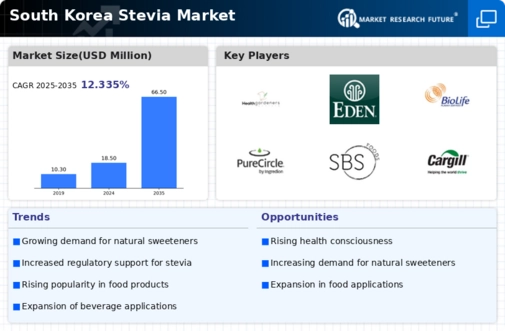Supportive Regulatory Environment
A supportive regulatory environment plays a crucial role in shaping the stevia market. In South Korea, government policies promoting the use of natural sweeteners have created a favorable landscape for stevia. Regulatory bodies have established guidelines that encourage the incorporation of stevia in food products, thereby enhancing consumer confidence. This regulatory support is reflected in the increasing number of approvals for stevia-based products, which has seen a rise of approximately 25% in recent years. As the stevia market continues to align with these regulations, manufacturers are more inclined to innovate and expand their product lines. This environment not only fosters growth but also ensures that consumers have access to safe and healthy alternatives to traditional sweeteners.
Rising Incidence of Lifestyle Diseases
The increasing prevalence of lifestyle diseases in South Korea serves as a critical driver for the stevia market. With conditions such as obesity and diabetes on the rise, consumers are becoming more vigilant about their dietary choices. Stevia, being a natural, low-calorie sweetener, presents an appealing alternative for those looking to manage their sugar intake. Recent statistics indicate that nearly 30% of the South Korean population is classified as overweight, prompting a shift towards healthier eating habits. This trend is likely to bolster the demand for stevia-based products, as consumers seek solutions that align with their health goals. The stevia market is thus positioned to capitalize on this growing awareness, as more individuals turn to stevia as a means of reducing sugar consumption and improving overall health.
Increasing Demand for Natural Sweeteners
The rising consumer preference for natural sweeteners is a pivotal driver in the stevia market. As health-conscious individuals seek alternatives to artificial sweeteners, stevia emerges as a favored choice due to its plant-based origin and zero-calorie content. In South Korea, the demand for natural sweeteners has surged, with market data indicating a growth rate of approximately 15% annually. This trend reflects a broader shift towards healthier eating habits, where consumers are increasingly scrutinizing ingredient labels. The stevia market is likely to benefit from this growing inclination, as manufacturers respond by incorporating stevia into a variety of food and beverage products. This shift not only caters to consumer preferences but also aligns with the increasing regulatory focus on reducing sugar consumption, further propelling the market forward.
Innovations in Food and Beverage Products
Innovative product development within the food and beverage sector significantly influences the stevia market. South Korean manufacturers are actively exploring new formulations that incorporate stevia, aiming to enhance flavor profiles while reducing sugar content. The introduction of stevia-infused beverages, snacks, and desserts has gained traction, appealing to a diverse consumer base. Recent market analysis suggests that the introduction of stevia in beverages alone could account for a 20% increase in product offerings by 2026. This innovation not only meets consumer demand for healthier options but also positions the stevia market as a key player in the evolving landscape of food and beverage trends. As companies invest in research and development, the potential for new applications of stevia continues to expand, fostering growth in the market.
Consumer Education and Awareness Campaigns
Consumer education and awareness campaigns are instrumental in driving the growth of the stevia market. In South Korea, initiatives aimed at informing the public about the benefits of stevia have gained momentum. These campaigns highlight stevia's natural origins, health benefits, and versatility in various culinary applications. As awareness increases, consumers are more likely to seek out stevia as a preferred sweetening option. Recent surveys indicate that over 40% of consumers are now familiar with stevia and its advantages, a notable increase from previous years. This heightened awareness is likely to translate into increased demand for stevia products, thereby benefiting the stevia market. As educational efforts continue, the potential for market expansion remains promising, with consumers becoming more discerning about their food choices.



















Leave a Comment